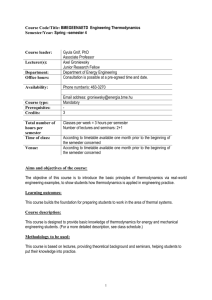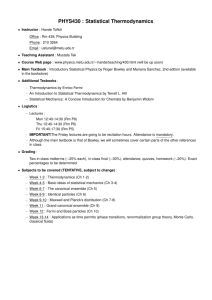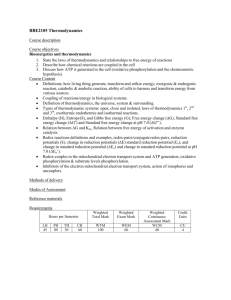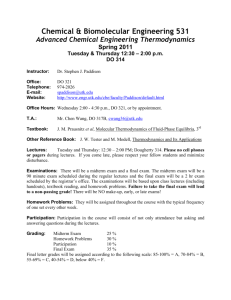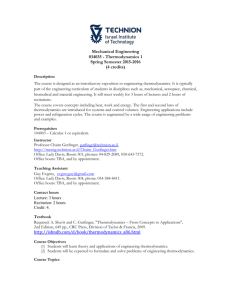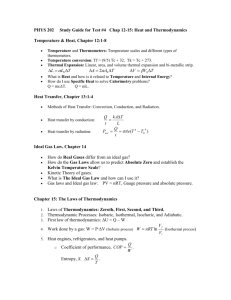Che 204 - Spring 2014
advertisement
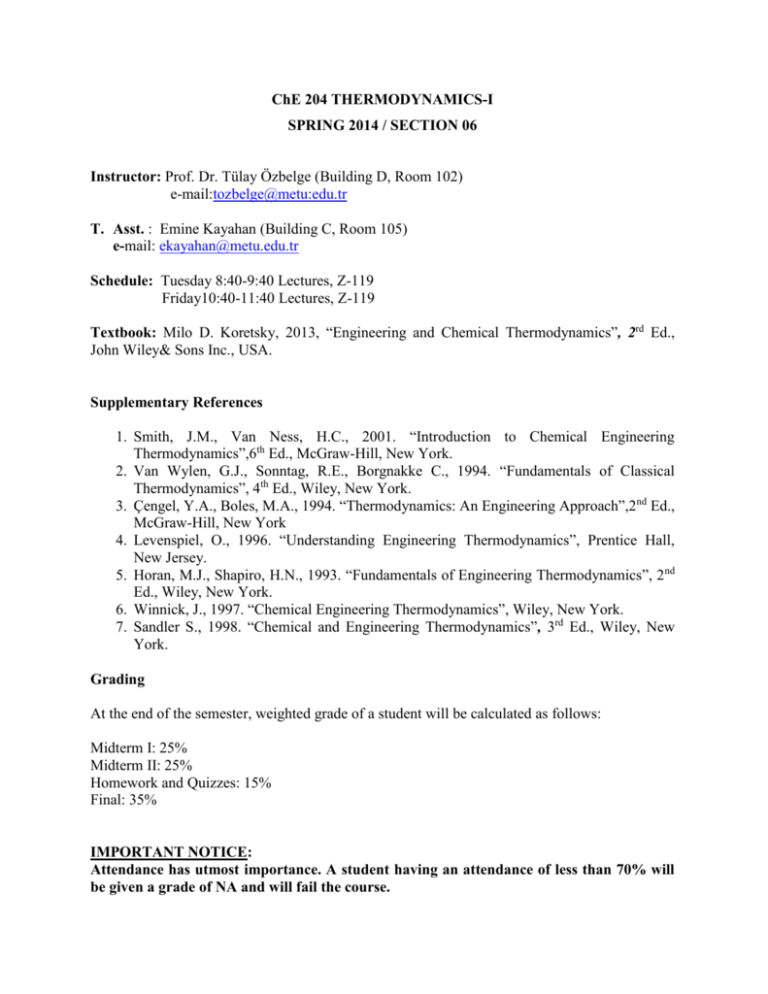
ChE 204 THERMODYNAMICS-I SPRING 2014 / SECTION 06 Instructor: Prof. Dr. Tülay Özbelge (Building D, Room 102) e-mail:tozbelge@metu:edu.tr T. Asst. : Emine Kayahan (Building C, Room 105) e-mail: ekayahan@metu.edu.tr Schedule: Tuesday 8:40-9:40 Lectures, Z-119 Friday10:40-11:40 Lectures, Z-119 Textbook: Milo D. Koretsky, 2013, “Engineering and Chemical Thermodynamics”, 2rd Ed., John Wiley& Sons Inc., USA. Supplementary References 1. Smith, J.M., Van Ness, H.C., 2001. “Introduction to Chemical Engineering Thermodynamics”,6th Ed., McGraw-Hill, New York. 2. Van Wylen, G.J., Sonntag, R.E., Borgnakke C., 1994. “Fundamentals of Classical Thermodynamics”, 4th Ed., Wiley, New York. 3. Çengel, Y.A., Boles, M.A., 1994. “Thermodynamics: An Engineering Approach”,2nd Ed., McGraw-Hill, New York 4. Levenspiel, O., 1996. “Understanding Engineering Thermodynamics”, Prentice Hall, New Jersey. 5. Horan, M.J., Shapiro, H.N., 1993. “Fundamentals of Engineering Thermodynamics”, 2nd Ed., Wiley, New York. 6. Winnick, J., 1997. “Chemical Engineering Thermodynamics”, Wiley, New York. 7. Sandler S., 1998. “Chemical and Engineering Thermodynamics”, 3rd Ed., Wiley, New York. Grading At the end of the semester, weighted grade of a student will be calculated as follows: Midterm I: 25% Midterm II: 25% Homework and Quizzes: 15% Final: 35% IMPORTANT NOTICE: Attendance has utmost importance. A student having an attendance of less than 70% will be given a grade of NA and will fail the course. Students are expected (i) to attend each and every lecture, (ii) to ask questions about the subject material and to participate in the class discussion without hesitation and (iii) to review and understand the previous lecture’s material before coming to each class, for better performance in their quizzes and exams. Policies & Procedures A web page has been constructed for the course. All the course materials (syllabus, homework assignments, etc.) will be made available on the web page. You need to visit the site on a regular basis to get recent homework assignments and other relevant announcements. If an open-book exam is given MT’s will be open-text book, and closed or open-class notes (no photocopies, only your own handwritten notes and class handouts). It is your responsibility to understand the exam questions. If you have difficulty with English, you may bring a dictionary with you. Starting from the first week of the semester ATTEND all the lectures, be sure that you understood the subject of the lecture, otherwise do not hesitate to ASK QUESTIONS during the lecture, be sure to REVIEW the material of the previous lecture before you come to the class, otherwise you will have difficulty to understand the lecture. If you miss an exam with a certified medical excuse, you may take a makeup exam at a designated time near the end of the semester. It will be CHALLENGING! You must work in groups of three on the required homework. The groups will be formed such that each group will contain at least one student with a cumulative grade point average (CGPA) of 2.00 or higher. However, each group may contain no more than two students with a CGPA of 3.00 or higher. One group member will be designated the leader for each assignment. The leader will be responsible for coordinating the work and making sure everyone in the group understands all the problem solutions before they are handed in. After being a group leader, an individual may not be leader again until everyone else in the group has held the position. Required homework will be due at the beginning of the period on the due date - one solution set per group. Use A-4 size paper and one side of each page. Follow the format provided below: - Problem statement - Given - Find - Schematic - System - Physical properties and equilibrium data - Assumptions - Analysis In drawing graphs, each and every graph that you drawshould have a title to identify it Coordinate axes should be named accordingly (e.g., pressure vs. temperature etc. the Units should not be forgotten.) If a student’s name appears on a solution set, it certifies that he/she has participated in solving the problems and understood all the solutions. If this turns out not to be the case, both the student in question and the group leader will be considered to have cheated and will be dealt with accordingly. To get an AA in this course, you must attempt and do satisfactory work on all homework problems in addition to getting the necessary weighted average grade on tests. Late homework will be accepted up to one week after the due date and will receive a maximum grade of 60 %. However, if a group abuses this privilege by routinely handing in homework late, the privilege will be withdrawn. There will be a gray area between each two letter grades in the final distribution, so that two students getting the same weighted average could get different letter grades. If you are in one of these gray areas, whether you get the higher or lower grade depends on three factors: a) Class attendance and participation in class, b) Your performance on homework problems, c) Whether your midterm exams and homework performance has been improving (your grade goes up) or declining (it goes down). SAMPLE HOMEWORK TITLE PAGE Ch.E. 204 THERMODYNAMICS-I HOMEWORK: 1 (Date due: Feb. 28, 2014) Submitted by : Group C Group Leader:…………. Group Members:………… Submitted to : Prof. Dr. A. Tülay Özbelge Asst. Emine Kayahan

